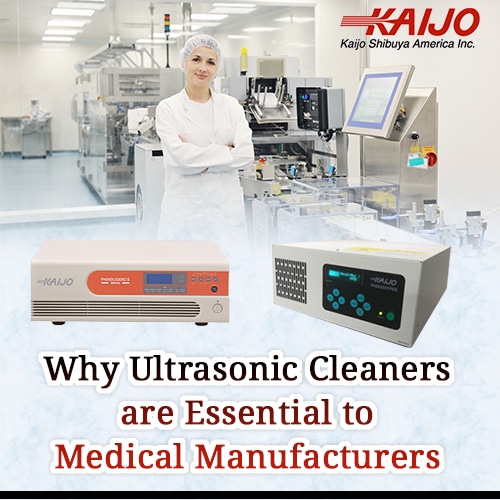Why Ultrasonic Cleaners Are Essential to Medical Manufacturers
May 19, 2021
 Because some modern medical equipment incorporates sensitive components such as electronics, sensors and optical fiber, traditional cleaning and sterilizing methods often can’t be used. Heavy contamination is removed with manual scrubbing and devices such as autoclaves use high-temperature steam to sterilize medical equipment. Sensors and delicate objects such as optical devices are easily scratched when scrubbed too hard. Fragile instruments can be damaged with manual scrubbing. Electronics can’t withstand the high temperatures of hot steam, and complicated devices have parts such as hinges, threaded holes and interior surfaces that are hard to clean.
Because some modern medical equipment incorporates sensitive components such as electronics, sensors and optical fiber, traditional cleaning and sterilizing methods often can’t be used. Heavy contamination is removed with manual scrubbing and devices such as autoclaves use high-temperature steam to sterilize medical equipment. Sensors and delicate objects such as optical devices are easily scratched when scrubbed too hard. Fragile instruments can be damaged with manual scrubbing. Electronics can’t withstand the high temperatures of hot steam, and complicated devices have parts such as hinges, threaded holes and interior surfaces that are hard to clean.
Ultrasonic cleaners provide the best alternative to traditional cleaning methods to remove contaminants without using chemicals, manual scrubbing or high temperatures. They can be configured to deliver strong cleaning action for robust parts or to clean gently when needed for fragile components or delicate surfaces. Ultrasonic cleaners can clean parts and devices with complex shapes, interior holes or along crevices. While ultrasonic cleaning does not sterilize, adding a disinfectant to the cleaning solution renders the clean parts sterile. As medical equipment gets harder to clean and cleanliness standards become tighter, ultrasonic cleaners are an ideal solution for the manufacturers of medical equipment.
Ultrasonic Cleaners Can Be Configured for Specific Medical Applications
Ultrasonic cleaners can clean a variety of medical devices, but they have to be configured correctly for optimal cleaning performance. An ultrasonic cleaner can clean hard surfaces quickly, but cleaners can also be configured to clean easily-damaged parts with a less intensive cleaning action. The ultrasonic cleaning system has to have enough power to fill the cleaning tank with ultrasonic waves, and if a sterilizing solvent is added to the cleaning solution, it can be chosen to remove a particular contaminant. Making sure ultrasonic cleaners are matched to the medical cleaning application ensures they will perform as expected and clean quickly and effectively.
The Choice of Ultrasonic Frequency Affects the Cleaning Intensity
Ultrasonic cleaners work by creating microscopic cavitation bubbles in the cleaning solution. As the ultrasonic sound waves pass through the cleaning tank, the bubbles form and burst in tune with the ultrasonic frequency. When a bubble bursts, it produces a tiny but powerful jet that can dislodge contaminants from the surface of the part to be cleaned.
Low frequencies create comparatively large bubbles and deliver powerful cleaning action. The higher the frequency, the smaller the bubbles. Smaller bubbles produce weaker jets and a gentler cleaning action. Choosing the right frequency matches the cleaning power to the medical equipment to be cleaned.
Choosing a System to Match the Medical Cleaning Application
Once the frequency is selected, key factors for effective cleaning include tank size and system power, the cleaning solution temperature, and any additions to the cleaning water. The longest dimension of the cleaning tank has to be long enough to fit the longest piece of medical equipment to be cleaned. Once the tank size is chosen, the ultrasonic system power has to match. Depending on the contamination and the part characteristics, heating the cleaning solution or adding a solvent can speed up cleaning.
Medical equipment manufacturers usually have different cleaning needs for different parts and devices. Implants may need a quick clean to remove shop dirt and a basic low frequency system may work well. Machined parts may be contaminated with oil or grease and a heated tank with a solvent specific to the contaminants will help clean quickly. Soft plastic parts, electronics and optical devices often need low-temperature soft cleaning. Ultrasonic cleaning allows customers to choose the system that works the best for them.
Kaijo provides extensive experience in ultrasonic cleaning at the disposal of customers in the medical equipment field. Kaijo’s ultrasonic cleaning systems can be customized for specific medical applications. With Kaijo’s expert advice, medical manufacturers can spend less time and money on cleaning equipment while meeting higher standards of cleanliness.





